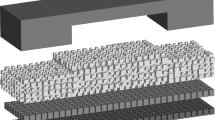Abstract
Numerical modelling of charge transfer using the finite element method within the whole active layer of proton exchange membrane fuel cell (PEMFC) electrodes is proposed in order to study the electrocatalyst utilization as characterized by the effectiveness factor. In this way, two modified approaches based on the thin film and agglomerate models are developed for studying ionic ohmic drop effects in the active layer at both the electrolyte layer and electrocatalyst particles scales. The catalyst phase is considered to be a network of spherical nanoparticles instead of the classical representation as a uniform distribution over a surface (thin film model) or in a volume (agglomerate model). Simulations point out unexpected effects at the local level due to the discrete distribution of the catalyst phase as nanoparticles. Finally, the results are applied to the practical case of oxygen reduction and hydrogen oxidation.
Similar content being viewed by others
References
M. Watanabe, H. Sei and P. Stonehart, J. Electroanal. Chem. 261 (1981) 375.
Y. Bultel, P. Ozil, R. Durand and D. Simonsson, 45th ISE Meeting, Xiamen (Chine), extended abstract, 2 (1995) 8.
Y. Bultel, P. Ozil, R. Durand and D. Simonsson, First International Symposium on Proton Conducting Membrane Fuel Cells, ECS proc. 95, Chicago (1995) 23.
A. Kabbabi, F. Gloaguen, F. Andolfatto and R. Durand, J. Electroanal. Chem. 373 (1994) 251.
A. Gamez, D. Richard, P. Gallezot, F. Gloaguen, R. Faure and R. Durand, Electrochim Acta. 41 (1996) 307.
T. E. Springer and S. Gottesfeld,‘Modeling of Batteries and Fuel Cells’, E. S. C. Proc. 91–10 (1991) 197.
F. G. Will, J. Electrochem. Soc. 110 (1963) 152.
J. Giner and C. Hunter, J. Electrochem. Soc. 116 (1969) 1124.
M. S. Wilson and S. Gottesfield, ibid. 199 (1992) L28.
S. Srinivasan and H. Hurwitz, Electrochim. Acta 46 (1992) 495.
P. Stonehart and P. Ross, ibid. 21 (1976) 441.
K. Kinoshita, J. Electrochem. Soc. 137 (1990) 845.
A. Parthasarathy, S. Srinivasan, A. J. Appleby, C. R. Martin, ibid. 139 (1992) 2530.
F. Gloaguen, F. Andofato, R. Durand and P. Ozil, J. Appl. Electrochem. 24 (1994) 863.
W. Vogel, J. Lundquist, P. Ross, and P. Stonehart, Electrochim. Acta 20 (1975) 79.
Author information
Authors and Affiliations
Rights and permissions
About this article
Cite this article
Bultel, Y., Ozil, P. & Durand, R. Modelling the mode of operation of PEMFC electrodes at the particle level: influence of ohmic drop within the active layer on electrode performance. Journal of Applied Electrochemistry 28, 269–276 (1998). https://doi.org/10.1023/A:1003207514936
Issue Date:
DOI: https://doi.org/10.1023/A:1003207514936




